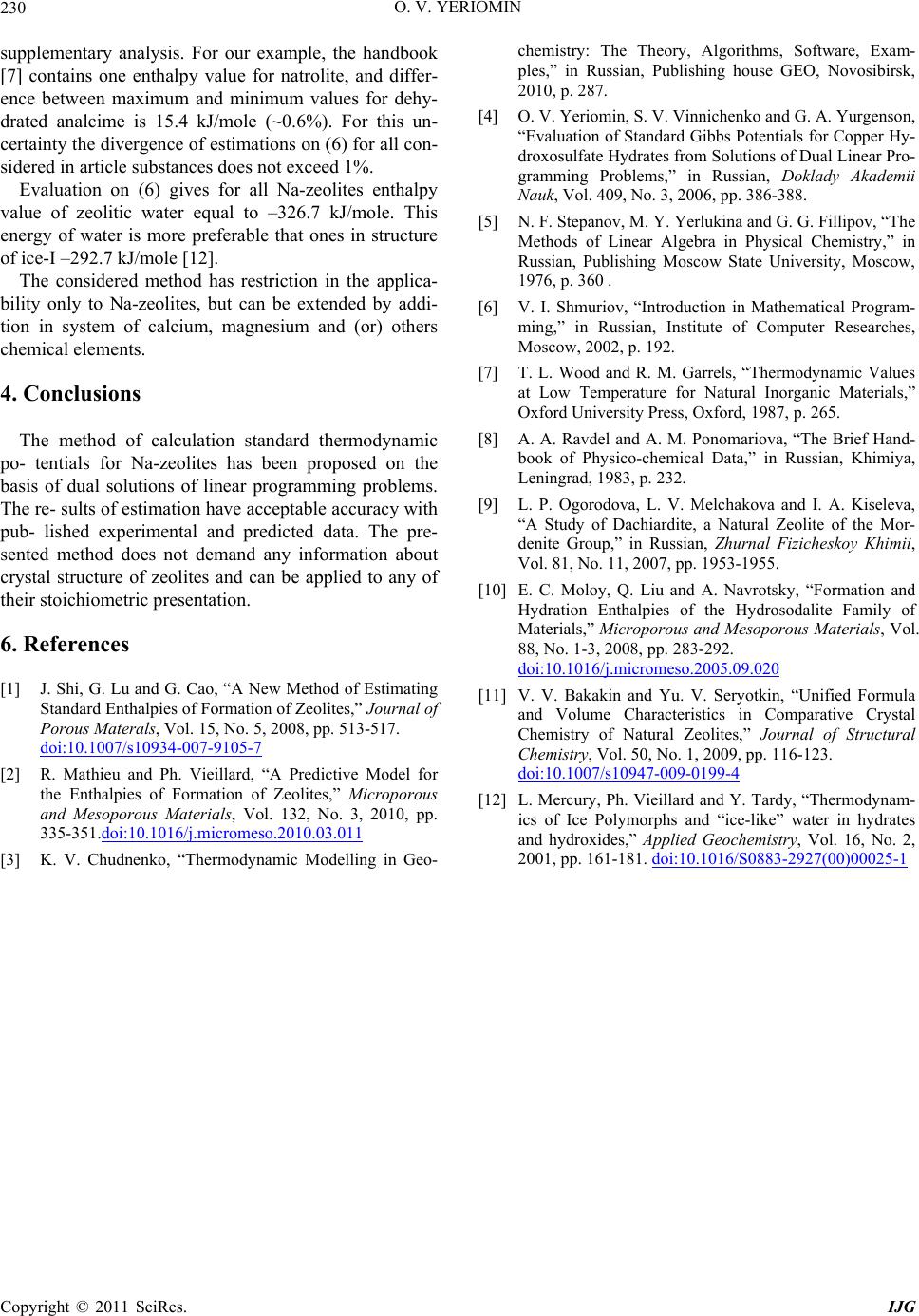
O. V. YERIOMIN
230
entary analysis. F
calculation standard thermodynamic
o
nd G. Cao, “A New Method of Estimating
supplemor our example, the handbook
[7] contains one enthalpy value for natrolite, and differ-
ence between maximum and minimum values for dehy-
drated analcime is 15.4 kJ/mole (~0.6%). For this un-
certainty the divergence of estimations on (6) for all con-
sidered in article substances does not exceed 1%.
Evaluation on (6) gives for all Na-zeolites enthalpy
value of zeolitic water equal to –326.7 kJ/mole. This
energy of water is more preferable that ones in structure
of ice-I –292.7 kJ/mole [12].
The considered method has restriction in the applica-
bility only to Na-zeolites, but can be extended by addi-
tion in system of calcium, magnesium and (or) others
chemical elements.
. Conclusions 4
The method of
p- tentials for Na-zeolites has been proposed on the
basis of dual solutions of linear programming problems.
The re- sults of estimation have acceptable accuracy with
pub- lished experimental and predicted data. The pre-
sented method does not demand any information about
crystal structure of zeolites and can be applied to any of
their stoichiometric presentation.
. References 6
1] J. Shi, G. Lu a[
Standard Enthalpies of Formation of Zeolites,” Journal of
Porous Materals, Vol. 15, No. 5, 2008, pp. 513-517.
doi:10.1007/s10934-007-9105-7
[2] R. Mathieu and Ph. Vieillard, “A Predictive Model for
the Enthalpies of Formation of Zeolites,” Microporous
and Mesoporous Materials, Vol. 132, No. 3, 2010, pp.
335-351.doi:10.1016/j.micromeso.2010.03.011
[3] K. V. Chudnenko, “Thermodynamic Modelling in Geo-
chemistry: The Theory, Algorithms, Software, Exam-
ples,” in Russian, Publishing house GEO, Novosibirsk,
2010, p. 287.
[4] O. V. Yeriomin, S. V. Vinnichenko and G. A. Yurgenson,
“Evaluation of Standard Gibbs Potentials for Copper Hy-
droxosulfate Hydrates from Solutions of Dual Linear Pro-
gramming Problems,” in Russian, Doklady Akademii
Nauk, Vol. 409, No. 3, 2006, pp. 386-388.
[5] N. F. Stepanov, M. Y. Yerlukina and G. G. Fillipov, “The
Methods of Linear Algebra in Physical Chemistry,” in
Russian, Publishing Moscow State University, Moscow,
1976, p. 360 .
[6] V. I. Shmuriov, “Introduction in Mathematical Program-
ming,” in Russian, Institute of Computer Researches,
Moscow, 2002, p. 192.
[7] T. L. Wood and R. M. Garrels, “Thermodynamic Values
at Low Temperature for Natural Inorganic Materials,”
Oxford University Press, Oxford, 1987, p. 265.
[8] A. A. Ravdel and A. M. Ponomariova, “The Brief Hand-
book of Physico-chemical Data,” in Russian, Khimiya,
Leningrad, 1983, p. 232.
[9] L. P. Ogorodova, L. V. Melchakova and I. A. Kiseleva,
“A Study of Dachiardite, a Natural Zeolite of the Mor-
denite Group,” in Russian, Zhurnal Fizicheskoy Khimii,
Vol. 81, No. 11, 2007, pp. 1953-1955.
[10] E. C. Moloy, Q. Liu and A. Navrotsky, “Formation and
Hydration Enthalpies of the Hydrosodalite Family of
Materials,” Microporous and Mesoporous Materials, Vol.
88, No. 1-3, 2008, pp. 283-292.
doi:10.1016/j.micromeso.2005.09.020
[11] V. V. Bakakin and Yu. V. Seryotkin, “Unified Formula
and Volume Characteristics in Comparative Crystal
Chemistry of Natural Zeolites,” Journal of Structural
Chemistry, Vol. 50, No. 1, 2009, pp. 116-123.
doi:10.1007/s10947-009-0199-4
[12] L. Mercury, Ph. Vieillard and Y. Tardy, “Thermodynam-
ics of Ice Polymorphs and “ice-like” water in hydrates
and hydroxides,” Applied Geochemistry, Vol. 16, No. 2,
2001, pp. 161-181. doi:10.1016/S0883-2927(00)00025-1
Copyright © 2011 SciRes. IJG